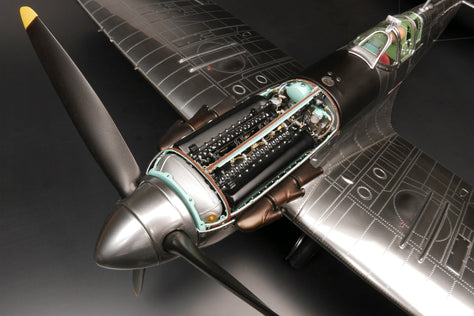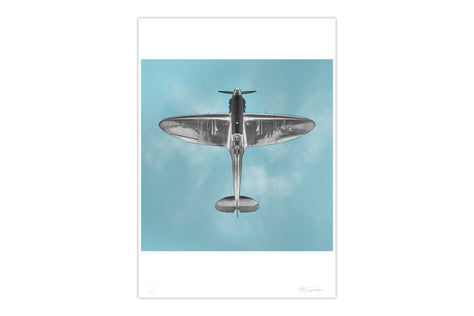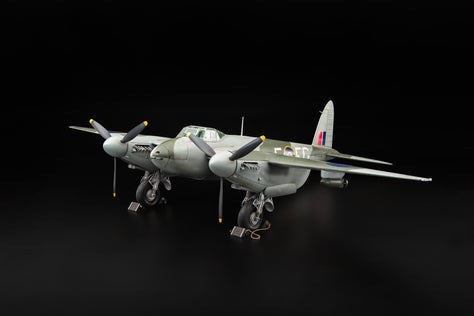
Technical Details
- Description
- Scale guide
- Limited Edition of 250 pieces
- Each model hand-built and assembled by a small team of craftsmen
- 1:4 scale model, over 42 cms/16 inches long and 27 cms/10 inches tall
- Made using the finest quality materials
- Over 3500 hours to develop the model
- Over 325 hours to build each model
- Thousands of precisely engineered parts: castings, photo-etchings and CNC machined metal components
- Built using original CAD designs developed from an original scan of a Merlin engine
A new development for 2025, our 1:4 scale replica of the Rolls Royce Merlin Engine will show every detail of the legendary V12 power unit. The Merlin engine achieved mythical status during the Second World War, powering many of the most iconic Allied aircraft from the Second World War, including the Spitfire, the Hurricane, the Mosquito, the Mustang and the Lancaster. It is considered to have been integral to the United Kingdom’s war efforts, frequently called the “engine that won the war”. We encourage customers to register their interest with our sales team for what we are sure will be a model high in demand.
Named after the United Kingdom’s smallest bird of prey Falco Columbarius, rather than the mythological wizard of King Arthur’s court, the Merlin was a British-designed liquid-cooled V-12 piston aero engine. Despite a smaller capacity than many of the aircraft it flew against, the Merlin would soon belie its namesakes little stature, and play a crucial role in the Royal Air Force’s victory in the Battle of Britain, and the subsequent invasion and liberation of Europe.
The engine was first developed privately by Rolls Royce in the early 1930s under the name PV-12, literally Private Venture 12-cylinder, as a successor to the highly successful Kestrel that powered the classic era of biplanes such as the Hawker Fury and Hart. The first ground run occurred on 15 October 1933 and first flew in a Hawker Hart on 21 February 1935, producing 740 horsepower. The engine suffered in early development and production with problems with the accessory gear trains, coolant jackets, cylinder head cracking, coolant leaks and excessive wear to the camshafts and crankshaft main bearings. Several different construction methods were tried before the basic layout was formalised. The design initially utilised an evaporative cooling system, but this was soon replaced by the more reliable ethylene glycol liquid cooling system developed in the United States. In 1935, the Air Ministry issued specification F10/35 for new fighter aircrafts with a minimum airspeed of 310 mph (500 km/h). Two particular designs had already been developed, both based around the Merlin engine: the Hawker Hurricane and Vickers Supermarine Spitfire. Production contracts were placed in 1936, and the development of the PV-12 was finally given government funding as a top priority. It was then the Merlin name was bestowed, following the company’s convention of naming its piston aero engines after birds of prey.
Producing the Merlin engine in sufficient numbers would be vitally important given that the Merlin would be the heart of over forty different aircraft over the course of its lifetime. The Rolls Royce plant in Derby, where much of the development and testing would take place, would go on to produce 32,377 Merlin engines, the Crewe Shadow Factory 26,065, a further 23,675 from the Glasgow Shadow Factory, and Ford Motor Company in Manchester another 30,428. Under a $130,000,000 order from Rolls-Royce, Packard Motor Car Company in America constructed an additional 55,523 Merlin engines. By the end of its production run, over 168,000 engines had been built.
Between 1939 and 1945, continual development of the Merlin ensured it was the powerplant for many wartime aircraft. The capacity of the Merlin was actually quite small when compared to its opposition; its capacity of 27 litres dwarfing in comparison to the 36 litre 1,175 hp DB601 of the Messerschmitt 109 and the 42 litre 1,700 hp BMW801 engine of the Focke-Wulf 190. However, the “little” Merlin was expertly engineered, and its high-power output was testament to that: In 1935, the Hawker Hurricane flew with a 1,030 hp; by the end of the war, the de Havilland Hornet flew with two Merlin units, giving a phenomenal 2,050 horsepower each. Over its production life, over 50 different development types of the Merlin Engine were produced and it saw operational service in 19 different types of aircraft, most notably the Hawker Hurricane, Supermarine Spitfire, de Havilland Mosquito, Avro Lancaster and the North American P-51 Mustang. Although the engine is most closely associated with the Spitfire, it was the four-engined Lancaster that was the most numerous application, followed by the twin-engined Mosquito. Post-war, the Merlin was largely superseded by the Rolls-Royce Griffon for military use, with most Merlin variants being designed and built for airliners and military transport aircraft, such as the Avro Tudor and the Canadair North Star. Merlin engines remain in Royal Air Force service today with the Battle of Britain Memorial Flight, and power many restored aircraft in private ownership worldwide.
This fine 1:4 scale model of the Rolls-Royce Merlin V12 Engine is the result of a powerful combination of art and technology, using original digital scanning combined with high sculpting and finishing skills to create a model indistinguishable from a real engine in photographs. It has been developed using extremely accurate digital scan data gathered from real engines, allowing us to perfectly recreate every detail at scale. Each individual material in the engine has been carefully and artfully reproduced at scale using special finishes as befits the Merlin’s design.
The Rolls-Royce Merlin V12 Engine is limited to just 250 pieces at 1:4 scale.
Pre-order
Bespoke
In order for us to create your bespoke model, you will need to choose 4 extra options. Paint colour, interior colour, wheel style and caliper colour.
Please complete the form and a member of our Sales Team will contact you.
Contact Us
Please contact us for more information about ordering this model.





